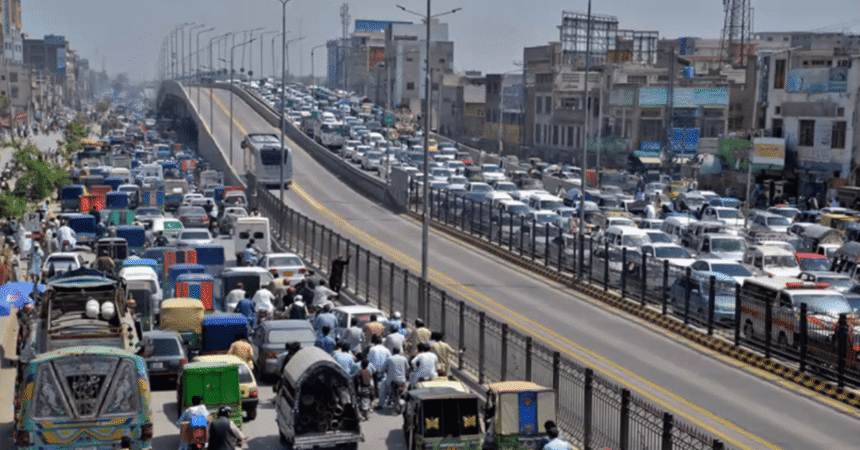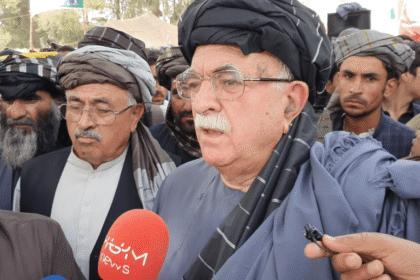KARACHI: A significant traffic disruption unfolded in Karachi on Tuesday morning, triggering widespread frustration and delays for thousands of commuters. The chaos began when a garbage dumper broke down on the Baloch Colony bridge during peak hours, bringing major routes to a standstill and highlighting the ongoing challenges faced by the city’s transportation infrastructure.
The Incident
At approximately 8 AM, the garbage dumper, which was reportedly in poor condition, came to a halt on the Baloch Colony bridge, a critical artery for morning commuters. Witnesses described a sudden wave of panic as drivers slammed on their brakes, trying to avoid colliding with the stationary vehicle. Within minutes, the bridge was completely blocked, creating a domino effect that spread congestion throughout several key thoroughfares, including Sharae Faisal, Karsaz (Stadium Road), and the Shaheed-e-Millat Expressway.
The morning rush hour is notorious for heavy traffic in Karachi, but this incident turned what is often a frustrating commute into a chaotic nightmare. Long lines of vehicles formed as frustrated drivers honked their horns and attempted to find alternate routes, only to discover that every surrounding road was also choked with cars. The initial shock of the breakdown quickly gave way to anger and impatience as people realized they would be late for work and other commitments.
Commuters’ Experiences
The human impact of the dumper breakdown was palpable. Commuters from various walks of life shared their stories of frustration and dismay. Many had left home with ample time to spare, only to find themselves stuck for hours in traffic.
Ahmed Khan, a local office worker, was one of the many who felt the sting of the unexpected delay. “I thought I’d left early enough to avoid the traffic, but I never imagined something like this could happen,” he said. “I missed an important presentation at work, and I feel completely stressed out. It’s just unacceptable.”
Fatima Ali, a university student, recounted how her day was derailed by the chaos. “I was on my way to class and thought I’d make it in time, but I ended up missing the entire lecture. I can’t believe how a single dumper could cause such mayhem,” she lamented.
As the hours ticked by, more and more commuters took to social media to vent their frustrations. Twitter and Facebook became platforms for sharing real-time updates, pictures of the gridlock, and anecdotes of the chaos unfolding. Hashtags like #KarachiTraffic and #DumperChaos began trending as users expressed disbelief at the situation.
Authority Response and Challenges
In response to the escalating traffic crisis, local traffic police and municipal authorities were dispatched to the scene to manage the situation. However, the complexities of the breakdown made the recovery process particularly challenging. The dumper was heavy and difficult to maneuver, and initial attempts to tow it away were hindered by the volume of traffic surrounding it.
For three long hours, traffic police struggled to restore order. Officers directed vehicles trying to navigate the bottleneck, but many drivers were frustrated and confused, unsure of which way to turn. Attempts to divert traffic to alternative routes only compounded the chaos, as those roads quickly became congested as well.
By 11 AM, authorities had finally managed to remove the damaged dumper from the bridge. However, the ripple effects of the incident continued to be felt across the city well into the afternoon, as residual traffic jams lingered and commuters remained delayed.
Broader Implications for Karachi’s Infrastructure
The dumper breakdown not only caused immediate chaos but also highlighted the broader issues plaguing Karachi’s transportation infrastructure. As one of the largest cities in the world, Karachi has a unique set of challenges when it comes to traffic management. The city’s rapid population growth and increasing vehicle ownership have strained its infrastructure, making it vulnerable to disruptions caused by accidents, breakdowns, and other incidents.
Urban planning experts have long argued that the city requires a comprehensive approach to traffic management and infrastructure development. The breakdown of a single vehicle should not have the capacity to paralyze an entire city; however, in Karachi, such incidents are often magnified by a lack of effective public transportation options and inadequate road maintenance.
To address these issues, urban planners suggest several long-term solutions, including:
- Investment in Public Transportation: Enhancing public transport systems can reduce the number of vehicles on the roads and provide commuters with reliable alternatives. Buses, light rail, and metro services can alleviate congestion, especially during peak hours.
- Road Maintenance and Upgrades: Regular maintenance of roads and infrastructure is crucial to prevent breakdowns. Authorities must prioritize funding for road repairs and upgrades, ensuring that vehicles can move smoothly without the risk of unexpected delays.
- Intelligent Traffic Management: Implementing smart traffic management systems can allow for real-time monitoring of traffic conditions. These systems can help manage the flow of vehicles and respond quickly to incidents, minimizing disruptions.
- Public Awareness Campaigns: Raising awareness about the importance of vehicle maintenance and responsible driving can help prevent breakdowns. Encouraging carpooling and the use of public transport can also foster a culture of shared responsibility among residents.
Public Reaction
The public response to the breakdown and subsequent traffic chaos was swift. Commuters took to social media to share their frustrations, and many called for greater accountability from local authorities. Comments ranged from disbelief to anger, with some users questioning how such a situation could arise in a major city like Karachi.
One Twitter user wrote, “If a single dumper can cause this much chaos, what will happen if there’s a major accident? We need better infrastructure and management!” This sentiment resonated with many who felt that the government and local authorities needed to take decisive action to address the city’s traffic woes.
Local community leaders also weighed in, emphasizing the need for collaborative efforts between residents and authorities. They suggested that community engagement could help in identifying critical areas needing attention and resources.
Government Initiatives
In the aftermath of the incident, local government officials acknowledged the pressing need for improvements in the city’s transportation infrastructure. The mayor of Karachi held a press conference to address the concerns of residents and outlined plans to review existing traffic management strategies.
Proposals included increasing the number of traffic officers deployed during peak hours and implementing a real-time traffic monitoring system that would provide updates to commuters via mobile apps and social media. The aim is to create a more responsive system that can handle unexpected disruptions more efficiently.
City planners also indicated that they would prioritize investments in public transportation, with plans for new bus routes and expansions of existing services. The government recognized that without an effective public transport network, the number of vehicles on the roads would continue to grow, exacerbating the traffic issues.
Community Engagement and Public Transport
Community engagement emerged as a key theme in discussions surrounding the breakdown. Residents voiced their desire for a more involved role in shaping transportation policies. Local forums and town hall meetings were suggested as platforms for community members to express their concerns and ideas.
One proposed initiative is the establishment of a transportation advisory board that includes residents, urban planners, and government officials. This board would be responsible for identifying critical infrastructure needs and developing plans to address them collaboratively.
In addition to community engagement, there is a growing call for enhancing public transportation options. Expanding bus services, implementing ride-sharing programs, and promoting carpooling could significantly reduce the number of cars on the road and lessen the impact of unexpected incidents.
Looking Ahead
The dumper breakdown on the Baloch Colony bridge is a poignant reminder of the vulnerabilities in Karachi’s transportation system. As the city continues to grow and evolve, the challenges of traffic management will only become more pronounced. Without proactive measures, incidents like this could become more frequent, leading to heightened frustration among commuters and decreased quality of life.
As discussions continue among government officials, urban planners, and community members, there is hope for a future where Karachi’s transportation infrastructure is better equipped to handle the demands of its residents. The journey toward a more efficient and reliable transport system will require a collective effort, with all stakeholders working together to implement long-term solutions.
In the wake of the dumper breakdown, the residents of Karachi are left grappling with the ramifications of a traffic system in dire need of improvement. While the chaos caused by a single vehicle has brought attention to the broader issues at play, it also presents an opportunity for meaningful change. By prioritizing infrastructure investment, enhancing public transportation, and fostering community engagement, Karachi can move toward a future where traffic chaos is a thing of the past.
#KarachiTraffic #DumperChaos #KarachiCommute #TrafficManagement #UrbanPlanning #InfrastructureImprovement







